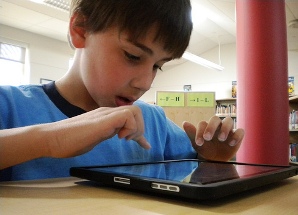How Orange County Schools Are Preparing To Go Digital

flickingerbrad / Flickr
Florida schools face a 2015 deadline to deliver more classroom lessons digitally, such as using iPads, tablets or e-readers.
FETC, one of the nation’s largest education technology conferences, opens in Orlando this week. StateImpact Florida will take a look at how state schools are trying to meet requirements to integrate more technology in lessons.
_______
Facing a 2015 deadline to add more digital textbooks and materials to classroom instruction, Orange County schools chief operations officer Michael Eugene has about as many questions as answers.
Eugene said digital instruction – using computers, tablets or e-readers – is more interactive and allows teachers to better engage students.
But while the benefits in the classroom could be big, Eugene and other state and local school leaders still sorting out the details:
What exactly does Florida law require in the way of digital teaching?
What materials and techniques work best?
How much internet bandwidth do schools need?
What’s all this going to cost?
“It’s a game-changer of a discussion,” Eugene said. “What is specifically meant by ‘digitally delivered discussion’?”
Florida’s textbook requirement is one of two big tech transitions facing Florida schools.
The other is the implementation of new, tougher education standards adopted by 45 states and the District of Columbia. These Common Core State Standards will require computerized testing starting in 2014. And experts believe companies that develop curriculum for schools will focus on digital content as they retool their products to meet the standards.
Digitally delivered content and Common Core will be big topics this week at FETC in Orlando. The event is one of the nation’s largest education technology conferences. About 10,000 educators will attend the event, which runs through Thursday.
The conference is a chance for teachers, principals and others to compare notes, share ideas and meet the companies behind the latest ed gadgets.
They meet as schools across the country are contemplating a technology overhaul to meet new, tougher education standards adopted by 45 states and the District of Columbia. Those standards take effect in the fall of 2014.
Matching Tools To The Task
Florida Department of Education deputy chancellor Mary Jane Tappen said school districts need to remember that some technology won’t work for students. Districts need to ask themselves what the most appropriate tool is for the different content areas, Tappen said.
If one thing is clear, Tappen said, it’s that it will be more convenient for districts to purchase digital content. Much like iTunes allowed customers to buy only the songs they want, schools and teachers will be able to pick and choose among lessons, texts and other resources.
Orange County schools deputy superintendent Jesus Jara said his district will plan around the material students are supposed to be learning — not the machine students are using.
“Our instruction is going to be driven by the curriculum,” Jara said. “It’s not going to be the fad of the technology or the device.”
But Jara said the district will emphasize technology in the classroom. Students are already using smart phones and tablets. Why not deliver lessons on a device they already love using?
“We don’t want [students] to come to school and power down,” he said.
Educators say incorporating more technology in education has many potential benefits.
Digital textbooks can be updated more quickly than print editions and can include interactive elements such as videos or a timeline. In addition, digital books may be less expensive than traditional books. The books are cheaper for publishers to produce and ship.
Long-term, educators hope technology might mean higher attendance rates and fewer discipline problems because students are more interested in their school work.
Orange County’s Experiment
Speed is another benefit: Tablets and computers can provide teachers instant feedback on how students are doing.
For instance, in one Orange County classroom every student has a tablet. When the teacher asks a question, he or she can instantly see which students got the answer right and which ones didn’t. The teacher can then follow-up with students who answered incorrectly.
And the tablet ensures that every student participates in class exercises – even the shy ones.
While new curriculum and technology will change how and what students learn, Michael Eugene said it will also change the way Orange County designs schools.
When every student has a laptop or tablet, Eugene said, “just imagine all the battery charging that has to go on. How many data ports does a classroom need?”
It’s fairly easy to add bandwidth or purchase devices, Eugene said. But adding technology might also force school districts to reallocate staff, adding more workers to help train and support instructional staff.
Those changes might take longer to carry out.
Orange County is picking 10 pilot sites next year to experiment with digital learning. Some schools, such as Audubon Park Elementary School, are early adopters of technology and digital materials. But the district will also pick schools which currently use little technology and might need to upgrade bandwidth or other capacity.
The district will study the results from those schools, as well as schools in Huntsville, Alabama, San Diego and Clearwater, to determine what works prior to the fall 2015 deadline to add more digital instruction.
Eugene says the district has no estimate yet on what the transition will cost, and the district expects just $10 million in state funding – so far.
“I think that timeline has some pressure,” Eugene says. “We’re going to find some unforeseen problems.”


